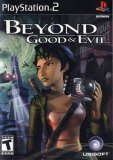Some videogames were just built out of the right stuff. Revolutionary, quiet, waiting in the wings—even overshadowed my more popular and more charismatic pieces they are yet pinnacles of the directions in which gaming can move. Beyond Good and Evil is a game such as this.
The game follows Jade, a photo journalist, through her adventures dealing with a military regime sent to protect the pastoral planet of Hillys against an invasion by hostile alien forces, the DOMZ. Jade is confident and very real heroine; someone that I was very happy to be my virtual eyes and hands in her world. The game unfolds itself carefully like a good spy novel, revealing new and strange things about both the DOMZ and the Hillys defense forces, the Alpha Sections. The gameplay fits solidly into the palm of action/adventure with some stealth elements, but it adds mission elements through the use of Jade’s camera. Her camera is a dimension that both aids the production of money for buying in-game goodies, but also to progress the story forward.
Released in late 2003 by Ubisoft, Beyond Good and Evil came and went without much fanfare or notice in most communities that I spent time. Spurred entirely by word of mouth about the game it took me a while to eventually discover it on sale at Best Buy. The best $23.99 that I have ever spent in my life.
As a game Beyond Good and Evil manages a spectacular package of social commentary on propaganda, press censorship, martial law regimes, and all manner of misbehaviors by government agencies. As a photo-journalist Jade suffers noticeably under the enforcement of these rules by the very people sent to protect them from the attacks, as do the occupants of her lighthouse-turned-orphanage for children displaced by the ongoing war.
Coming to this game originally, via a demo, I found that the cartoon style set some expectations and moods of the game that followed me throughout. The visuals are not exactly stunning or awe-inspiring, but every setting is well crafted and carefully designed to always be consistent and proper. The cartoon nature doesn’t detract from the settings but instead adds a sense of the everyplace to everything that I visited—as if I was looking at a place I might actually visit someday. The people are vivid characters, although weird in their way, and they too suffer and act in their own ways during the course of the story.
As visual media, Beyond Good and Evil presents a world of anthropomorphic animals as people. At first this put me off, especially at the very beginning when Pey’J—Jade’s uncle and one of the more lovable and awesome characters in the story—jumps in to help fight a DOMZ invader on the ground, but the excellent dialogue and real personality of the various characters quickly won me over.
The storytelling aspects of this game added with the excellent voice acting really give an empathic edge to the plight of the characters. By the time things really got going I wanted to help them, and you will too. This game really gets your heart going, not just in rate but in sympathy, it puts you into the thick of the strange, boots in the dirt, camera in one hand, and a weapon in the other.
From the beginning of the game the foreshadowing hits hard. There is a distinct since that in this idyllic seaside town something is not right, and it isn’t just the ongoing attacks by the DOMZ, or the strange barriers to travel set up “for your protection.” Another thing that Beyond Good and Evil does an excellent job of excusing is why we cannot fly beyond the edges of the map. No invisible force blocks us from leaving; instead military drones come to collect us.
The sidekicks that Jade receives on her journey are colorful and interesting characters—and though their repeated phrases are too few and wear just slightly thin, their jocularity and banter bring them out worthy companions. Pey’J, in his role as trusty companion and uncle, does spend a bit of time with Jade and brings his own…porcine view to the world, although he is a bit gruff and chafing in his jocularity, he is otherwise a fully dimensional character. Double-H, an IRIS Network agent working to reveal the strange conspiracy that grips Hillys stands out as a parody of every jock SciFi hero, and while he comes off as short of brains but long on bravery, I ended up fully dedicated to pulling his sorry hide out of the fire when the time came. And although he’s not a sidekick, for some weird reason the leader of the IRIS Network reminds me a lot of Laurence Fishburne.
This game may have arrived with very little fanfare from the community at large, but it will always keep a warm corner of my heart. Other videogames could really learn a lot from its storytelling technique: the use of the camera to provide extra additions to the traditional action/adventure title; the gradual unwrapping of the conspiracy; and equally so the changes in the opinions and the population as the game continued onwards.
When the game ended, I looked back at the story and wanted more—there needs to be more—I fell in love with all the characters, Hillys, and their ongoing predicament. Jade, Pey’d, Double-H…they will all live on in my memory and I hope to see a sequel to this in my lifetime.
YOUR LEADERS LIE! JOIN US AT THE IRIS NETWORK! ARISE HILLYS!


Recent Comments